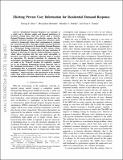| dc.contributor.author | Zhou, Datong P. | |
| dc.contributor.author | Balandat, Maximilian | |
| dc.contributor.author | Dahleh, Munther A | |
| dc.contributor.author | Tomlin, Claire J. | |
| dc.date.accessioned | 2020-04-14T14:34:22Z | |
| dc.date.available | 2020-04-14T14:34:22Z | |
| dc.date.issued | 2018-01 | |
| dc.identifier.isbn | 9781509028733 | |
| dc.identifier.isbn | 978-1-5090-2872-6 | |
| dc.identifier.isbn | 978-1-5090-2874-0 | |
| dc.identifier.uri | https://hdl.handle.net/1721.1/124618 | |
| dc.description.abstract | Residential Demand Response has emerged as a viable tool to alleviate supply and demand imbalances of electricity during times when the electric grid is strained. Demand Response providers bid reduction capacity into the wholesale electricity market by asking customers to temporarily reduce consumption in exchange for a monetary incentive. This paper models consumer behavior in response to such incentives by formulating Demand Response in a Mechanism Design framework. In this auction setting, the Demand Response Provider collects price elasticities as bids from its rational, profit-maximizing customers, which allows targeting only the users most susceptible to incentives such that an aggregate reduction target is reached in expectation. We measure reductions by comparing the materialized consumption to the projected consumption, which we model as the '10-in-10'-baseline used by the California Independent System Operator. Due to the suboptimal performance of this baseline, we show, using consumption data of residential customers in California, that Demand Response Providers receive payments for 'virtual reductions', which exist due to the inaccuracies of the baseline rather than actual reductions. Improving the accuracy of the baseline diminishes the contribution of these virtual reductions. Keywords: Load management; Electricity supply industry; Aggregates; Contracts; Elasticity; Buildings | en_US |
| dc.language.iso | en | |
| dc.publisher | Institute of Electrical and Electronics Engineers (IEEE) | en_US |
| dc.relation.isversionof | http://dx.doi.org/10.1109/cdc.2017.8263664 | en_US |
| dc.rights | Creative Commons Attribution-Noncommercial-Share Alike | en_US |
| dc.rights.uri | http://creativecommons.org/licenses/by-nc-sa/4.0/ | en_US |
| dc.source | arXiv | en_US |
| dc.title | Eliciting private user information for residential demand response | en_US |
| dc.type | Article | en_US |
| dc.identifier.citation | Zhou, Datong P. et al. "Eliciting private user information for residential demand response." 2017 IEEE 56th Annual Conference on Decision and Control, 12-15 Dec. 2017, Melbourne, VIC, Australia, Institute of Electrical and Electronics Engineers, 2017 | en_US |
| dc.contributor.department | Massachusetts Institute of Technology. Laboratory for Information and Decision Systems | en_US |
| dc.relation.journal | IEEE 56th Annual Conference on Decision and Control | en_US |
| dc.eprint.version | Original manuscript | en_US |
| dc.type.uri | http://purl.org/eprint/type/ConferencePaper | en_US |
| eprint.status | http://purl.org/eprint/status/NonPeerReviewed | en_US |
| dc.date.updated | 2019-05-14T14:52:10Z | |
| dspace.date.submission | 2019-05-14T14:52:11Z | |
| mit.metadata.status | Complete | |
